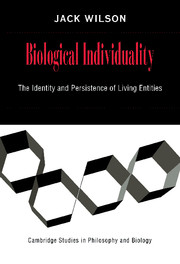Book contents
- Frontmatter
- Contents
- Acknowledgements
- 1 Beyond Horses and Oak Trees
- 2 The Biological and Philosophical Roots of Individuality
- 3 Individuality and Equivocation
- 4 The Necessity of Biological Origin and Substantial Kinds
- 5 Generation and Corruption
- 6 Personal Identity Naturalized
- Appendix: Identity and Sortals
- Notes
- References
- Index
2 - The Biological and Philosophical Roots of Individuality
Published online by Cambridge University Press: 05 December 2011
- Frontmatter
- Contents
- Acknowledgements
- 1 Beyond Horses and Oak Trees
- 2 The Biological and Philosophical Roots of Individuality
- 3 Individuality and Equivocation
- 4 The Necessity of Biological Origin and Substantial Kinds
- 5 Generation and Corruption
- 6 Personal Identity Naturalized
- Appendix: Identity and Sortals
- Notes
- References
- Index
Summary
In this chapter I begin by briefly exploring some of the ways in which individuality is an important topic for biologists, even those without a theoretical bent. I end the first section with a pair of case studies demonstrating the reality of the problem I hope to solve. In the following sections I sketch some representative philosophical positions about the substantial kinds for living things. I end this chapter by developing a theory of natural kinds that will effectively underwrite the particular ontology of living things that I will develop in Chapter 3.
WHY BIOLOGISTS (SHOULD) CARE ABOUT INDIVIDUALITY
There is an interesting and often weird body of writing on individuality by biologists. T. H. Huxley (1852) and Julian Huxley (1912) both wrote about it. So did Haeckel (1879). At the turn of the century there was a spurt of odd monographs exploring individuality and development through cutting flatworms into bits and in other ways testing the literal meaning of an individual as something that could not survive division.
Biologists have been making sporadic attempts to clarify conceptual and empirical issues about the identity and individuation of biological entities for a long time. Conceptual concern about the necessary and sufficient conditions for fulfilling the concept of an organism seem to have become fashionable several times in the past and then faded again into obscurity without resolution. The concept of individuality has been at the center of concerns about how to distinguish a tightly integrated colony from an organism, issues about what kinds of entities are involved in natural selection, as well as the idea that if population biologists are to be able to do their jobs, they have to be able to decide how many things of a specific kind they are looking at.
- Type
- Chapter
- Information
- Biological IndividualityThe Identity and Persistence of Living Entities, pp. 22 - 47Publisher: Cambridge University PressPrint publication year: 1999



